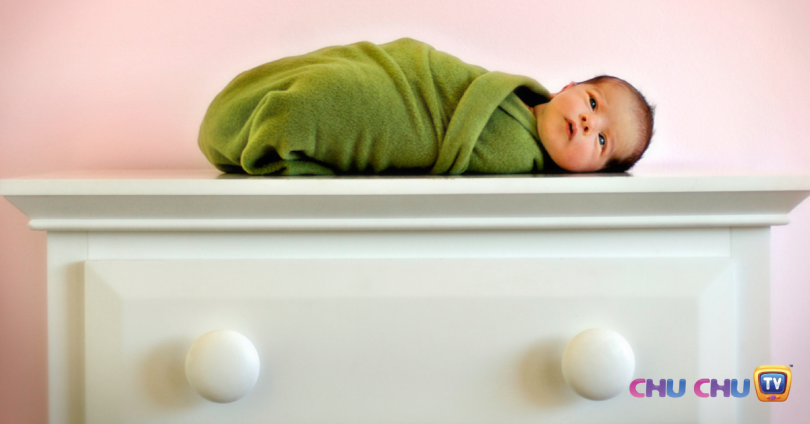Swaddling is a great way to ensure warmth and security for your newborn baby. It’s an art since your baby looks absolutely adorable when she is snugly wrapped in a comfortable blanket. Science research has shown that swaddling helps babies to sleep better and keeps them warm and comfortable. The way it works is that it mimics the conditions inside the womb, which naturally makes the newborn baby feel cozy, safe and contented. Another good thing about swaddling is that it is quite easy to learn. All you need is a soft, comfortable swaddling blanket and understand the basic folds needed to create the swaddle for the baby. If you do it right, your newborn baby is sure going to love it. Here’s how you can do it.
Step 1: A square shaped blanket works best for swaddling a newborn baby and it should preferably measure at least “40×40”. The blanket’s thickness would depend on the immediate environment. It needs to be slightly stretchy, so as to ensure a snug fit around the baby. You need to spread the blanket diagonally on a flat surface, in a diamond shape, with the bottom end pointing at you.
Step 2: Fold the top end of the blanket towards the center. You can adjust this fold as per the height of your baby.
Step 3: Place the baby over the fold, so that her neck is parallel to the top fold. Make sure you provide adequate support to her neck and body when you do this since newborn babies are very fragile.
Step 4: Hold the baby’s right arm and place it by her side. You can do this process right to left or left to right; it’s up to you. The arm can also be placed close to your baby’s chest or tummy. This technique is said to mimic the conditions of the womb more accurately, but it’s up to you. Now, pull the corner to your left and wrap it around the baby. The end of the corner should go under the left arm of your baby. Place the baby’s left hand over the corner and hold it there.
Step 5: Lift the bottom corner of the blanket and wrap it around the baby, towards their left shoulder. Secure the end in between her left shoulder and the bottom layer. While doing this, ensure that there’s adequate space for the baby to freely move her feet within the swaddle. This will reduce the risk of overheating and will also be crucial in preventing hip dysplasia in the long run.
Step 6: Take the right corner of the blanket and wrap it around the baby, towards their right shoulder. Now, tuck the end in the back of the swaddle.
Step 7: Done! You have successfully swaddled your newborn baby. Please note that the above-described method is a V-neck swaddle. This swaddling technique is considered to be one of the most comfortable and secure for a newborn baby. There are other types of swaddling techniques as well that you can try for your baby.
Swaddling Safety
Here are some precautions you need to take while swaddling your newborn baby:
The swaddle should not be too tight:
Swaddling too tight may put additional pressure on the baby’s lungs, making it difficult for them to breathe. However, it should also not be loose, as it will negate the benefits of swaddling. The swaddle should be snugly wrapped around the baby to make it feel comfortable and secure. You can observe the baby for a few minutes after swaddling to ensure that everything has been done perfectly.
The baby should never be placed on their stomach when swaddled:
Lying on their stomach when swaddled can interfere with their breathing, so ensure that the baby is placed on their back when swaddled. This safety precaution also needs to be followed when the baby is sleeping.
The crib should have a firm mattress:
Soft mattresses have known to interfere with the baby’s breathing. Ensure that the mattress you use in the crib is of a firmer quality. A firm mattress will also prevent suffocation in case the baby rolls over on their stomach during sleep.
Don’t place anything inside the crib:
Anything inside the crib is a potential hazard for a newborn baby, especially when they are sleeping. Make sure there are no additional items in the crib such as pillows, stuffed animals, etc.
Don’t use a pacifier when swaddled:
Sometimes, babies need to breathe through their mouth. A pacifier may prevent this from happening, especially when the baby has been swaddled. The baby may resist initially when you remove the pacifier, but if you give it time, they will eventually learn to live without it.
Why Swaddle – Benefits of Swaddling
Reduce SIDS– Swaddling has shown to reduce the risk of Sudden Infant Death Syndrome (SIDS). SIDS can occur when the baby accidentally ends up covering their face while bedding or through any other item lying around them. It can also occur when the baby flips over onto their stomach. Swaddling has known to prevent both these events from happening.
Reduce crying– Since swaddling recreates the environment similar to that of a womb, swaddled babies feel more secure and comfortable. This is why swaddled babies cry less as compared to babies that are not swaddled.
Improve sleep – Swaddling has shown to improve sleep among babies, which is essential for their general health and well-being and also for their overall growth and development. It works both qualitatively and quantitatively, allowing the baby to experience a deep sleep as well as a sleep that occurs for long periods of time at a stretch.
When to Stop Swaddling your newborn baby
The American Academy of Pediatrics (AAP) recommends that you should stop swaddling your newborn baby when they are 2 months old. At 2 months and beyond, there’s an increased possibility that the baby may flip over onto their stomach, which can interfere with their breathing. After two months, you can switch over to other options such as sleeping sacks or wearable blankets.










Leave a Comment